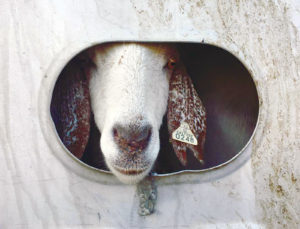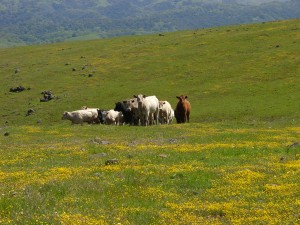When two hikers complained to state park rangers recently about an area severely trampled by grazing cows, they drew on a strong current of suspicion that many people feel toward ranchers. And why not? Past ranching and range-management practices, even if undertaken with the latest research and the best intentions, have sometimes done significant damage across the American West, destroying stream banks and driving out native plants. But the hikers had it wrong this time. Meet Joe Morris, the owner of those cattle and others that roam on 7,500 acres that encompass two state parks and four ranches near San Juan Bautista. This fifth-generation rancher has the health of the land very much in mind.
JM: I wish I could have talked with those hikers and told them how much I love this land and how cows can work to make a healthier landscape. The land they were passing has medusa-head, an annual grass that’s a noxious weed in anybody’s book. It’s very unpalatable to most critters; you really sacrifice your animals’ health if you try to graze it. As an alternative, we can use animal impact—all the rest of what the cow does: trampling, dung, urination, etc.—to keep that grass in check.
We ask ourselves: how are we creating a space for the medusa, and what can we do so that this plant doesn’t want to be here? The medusa-head is susceptible to animal impact as a seedling, so the herd’s impact will damage it at its weakest stage in life, while creating a habitat for plants we want to replace it with. There’s almost no animal impact with just a few animals. A big herd has tremendous energy, and that energy can be put onto the soil by grouping the animals, milling them around, leaving them in a relatively tight group. Our animals work for us to produce the landscape that we desire. It’s composed mainly of the native perennial grasses in our grassland savannas, and a variety of other meadow plants, shrubs, and oaks and plant populations that include young, middle-aged, old, and dying individuals.
So when the hikers in horror said, “Look at the overgrazing,” what they saw was animal impact, not overgrazing. The animals had been there for only 18 hours. Over time, we can create a space for the perennial grasses without using massive amounts of dollars. In fact, we can use the sun’s energy to power this whole project.
Q: What other tools do you use to manage the land?
JM: There are six main tools: grazing, resting the land, living organisms (for example, in biologically integrated farming systems), fire, technology, and animal impact, which is poorly understood and mostly not used. My decision on which tool to use has to be ecologically and economically sound, as well as socially just. So I ask myself several questions: How does it move the landscape toward my goal? Is it economically sound? If we are not profitable, we’re not sustainable. It also has to fit my view of social justice and satisfy me personally; that is, how can I feel good about using this tool so my neighbors don’t object and, in fact, so they feel good about the results?
We spend time with the animals and plants to observe how things are working. What are the plants telling us? We make daily observations, take pictures, and monitor growth rates, always asking, are we moving the animals too fast, too slowly? Is the water clear coming past our ranch or is it dirty? And why? That continual process is what informs future decision-making.
Q: What influenced you to try this nontraditional approach to cattle ranching?
JM: At one point in my life after college, I was teaching a course in a Washington, D.C., high school on social justice and I ran across the work of [rural philosopher] Wendell Berry. He helped me understand connections between agriculture and culture—the common good, and how ranching, done in a particular way, could contribute to that.
Then I found the work of Allan Savory about tools and information that had been missing in our attempts to manage rangelands, tools that relate to sustainable civilizations. So that knitted together all my desires—ecological, economic, and social justice—and gave me a framework in which I could go back to my family’s tradition of ranching, which I did in 1991.
Q: We’re supposed to be talking about cattle ranching, and we haven’t talked about cows at all. It sounds like the cows will take care of themselves if you take care of the land well.
JM: That’s it in a nutshell. If you have healthy land, you’re going to have healthy animals. If done properly, grazing is not stressful for them. It’s what they do. They eat; they trample things; they’re gregarious; they like being together. It is about the land. Agriculture is about producing food and fiber using solar energy and ecological processes – the water cycle and the mineral cycle and understanding community dynamics. Rain falls on our rangelands and they in turn provide a protective place to store water, and the best place for that storage is in the organic matter of the soil deposited there by fibrous-rooted perennial plants and grasses.
Q: How exactly can grazing favor perennial grasses?
JM: Perennial plants in arid environments need disturbance to remain healthy. Grazing and animal impact remove the thatch of the previous year’s growth. Properly timed, grazing removes leaves from the growing plant, and the plants’ roots then die back, adding to the store of organic matter in the soil, and feeding the animal responsible for the health of the plant. “Overgrazing” is a second bite taken from a plant before it has the opportunity to build up roots and leaves after the first bite. This is a management problem, not an inherent dissonance between plants and animals.
Q: People skeptical about grazing’s benefits might not agree with the notion that it can actually increase the diversity of plants in an area. How does that work?
JM: Holistically planned grazing varies the intensity, duration, and frequency of grazing to create a mosaic of plants and habitats on the range. Native grasses respond to grazing in a variety of ways, but research done in the 1930s showed that, in annual grasslands, perennial grasses propagated best from seed if the annual plants [were grazed] low until about March or April or when the moisture in the soil started to wane. When that happened, the annual grasses no longer could use much moisture, so they grew up, produced a seed, and then maintained a fairly low profile. The perennial grasses by that time had put down roots that continued to draw moisture, when the annual plants could not. So the perennials did well.
Q: Has your holistic system translated into a successful business?
JM: T.O. Cattle Company is about two things: One is land management, the other is our grass-fed beef. In the last few years there’s been an astounding amount of research that’s shown how animals raised on and fed only grass have a different nutritional profile in their beef than animals fed grain. To complement that, you have healthy animals working to create wonderful landscapes. We have none of the ecological problems that are unavoidable in the feedlot system.
Q: What’s the market for grass-fed beef?
JM: It’s a growing niche market. We offer our beef directly to families. That relationship is of fundamental importance – economically as well as socially and ecologically sound. We’re trying to connect people with our product as well as with the soils, the sun, and the plants that produce what, transformed, becomes them. That’s what we’re about.
For more information on T.O. Cattle Company and how to order their products, see www.morrisgrassfed.com.

.jpg)



